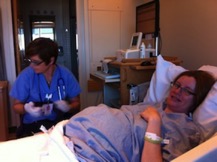Past due
TIME TO EVICT OUR BABY FROM MOM
08/10/11 22:20

It’s been an amazing 9 months for my wife and I as we near the end of her pregnancy. It has been a time for us to grow closer, dream bigger and worry like we’ve never worried before.
After 14 days of extra lodging inside mommy, it’s time for our newborn to come out into the sunshiny world of Boston in October. After 42 weeks in the mother’s womb, complications can occur that can harm the baby so our doctor recommended intervention. It’s also called induction.
As I sit and write this, my wife is walking around the delivery room in her johnny (hospital gown for the Euro crowd); looking out the window, checking out the baby warmer and eating a chicken salad sandwich. We have recently been informed we could be here for days. Days? What? I thought things moved along fast now that medicine was intervening. Not so.
We arrived at 9:30am to MGH in Boston and we were admitted promptly to our room. It’s a nice room and it’s private. Our nurse, Susan, is very friendly and is very good to Val. Our anesthesiologist, Steve, is a graduate from my alma mater, the University of Texas, and he seems quite knowledgeable and nice. The resident doctor, Andrew, is fab and is very communicative as to what to expect as the day(s) progress.
It was then that we realized that an induction is a process that can take days, not hours. Valerie and I looked at each other with our jaws dropped. We’ve been reading books, going to regular doctor visits, taking a five week birthing class and nowhere along the way did anyone say anything about taking days to induce labor.
The doctor went on to explain that it’s not good to trigger the contractions right away until the rest of the body is also ready to “receive the baby.” It takes time for the birth canal to open up and become flexible enough for the baby to come out. So you don’t want to start the contractions if the birth canal isn’t ready. The doctor starts the process with a little pill that relaxes the birth canal. One every 4 hours. And between each pill, they check to see if the cervix is opening properly. During this time, the opening of the cervix could trigger contractions to begin. That’s a good bi-product because it means the body is taking over and no more artificial means may need to take place.
If contractions don’t start on their own and yet the cervix is beginning to open to around 3 to 5cm, the next step is for the doctor to administer pitocin. Pitocin will definitely trigger contractions to start. And since it is a medicine to kickstart the contractions, the contractions are stronger and they hurt more. Perhaps a lot more.
But at the moment, it’s all here-say because my wife is just laying in bed wondering what will happen next. She says its the calm before the storm. I’m looking for an umbrella.
Comments